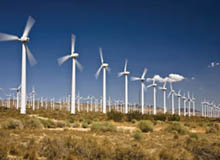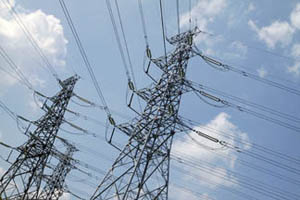Montana is a big, beautiful playground for the wind. It howls down the eastern edge of the Rocky Mountains from the north and west, and flies south and east across the empty plains of the eastern part of the state. But that Montana wind turns just 375 megawatts worth of wind turbines. That’s 30 percent as much as comparatively calm and crowded New York State, even though Montana’s strong and consistent wind has the potential to produce almost nine times as much electricity as New York’s.
Montana even lags its windy neighbors, North Dakota and Wyoming. The reason is location. Montana is the extreme example of the problem with renewable power in the United States and worldwide: Renewable natural resources often exist far from people who need electricity, and it is expensive to build or upgrade transmission lines to move it to them. And in the lower 48 states, Montana is just about as remote as you can get.
Transmission Troubles
“We could be the wind energy leader of the West,” says Chantel McCormick, Senior Energy Development Specialist for the State of Montana. “All that stands in the way is transmission.” The problem is that there’s much that stands in the way of actually building that transmission—including, of course, cost. Wind and solar are already expensive compared with the main sources of electricity in the United States—coal, natural gas, and uranium. Add the cost of building transmission lines (and the cost of the electricity lost in transit), and building in places like Montana just isn’t worth it, even with subsidies for green power and mandates that specify how much green power states must use every year.
The fact that bureaucracy and politics are at play is hardly surprising. And building on land owned by various federal agencies is always going to be difficult.
There are a half-dozen transmission lines in early stages of development in the state, all of which are designed to get wind power to the West Coast or Las Vegas. It’s unclear if any will be built and, if so, how long each will take. Transmission is one of the most notoriously difficult projects to site, permit, and construct. Projects are known to take 10 to 15 years to get up and moving juice. The reasons are legion, but stem primarily from the fact that lines cross land owned by so many different owners.
Electricity transmission is regulated by state public utilities commissions, so project approvals often get tangled in politics. Building lines that cross several states is even more difficult because state utility commissions have little interest in approving projects designed to help customers in other states (The Federal Energy Regulatory Commission has no power to site lines for the national good, the way it does with natural gas pipelines).
The fact that bureaucracy and politics are at play is hardly surprising. And building on land owned by various federal agencies is always going to be difficult. But it turns out that even siting transmission lines on private land is difficult—far more difficult than, say, siting a wind turbine. The reason is the way landowners are compensated—or not—for transmission.
Wind Resistance
If a developer wants to put a wind turbine on a patch of private land, he offers to pay a per-acre fee and a percentage of the revenues produced by the turbine. Landowners jump at the chance; siting wind is not a problem in Montana or elsewhere across the West. Ranchers and farmers are eager to harvest wind along with wheat and cattle.

If you paid a fairer price, people would be fighting for transmission to be on their land. It’s the single most important factor in getting transmission built.
Predictably, it’s not nearly enough to compensate owners for what the wires do to the value of their land, so they fight against it instead of for it. It’s a case of “not in my backyard”—at least at that price.
“If you paid a fairer price, people would be fighting for transmission to be on their land,” says Hertha Lund of the Wittich Law Firm in Bozeman. Lund helps landowners and developers negotiate wind transactions. “It’s the single most important factor in getting transmission built.”
McCormick notes that the state is trying to help: in 2007 it passed a law to exempt land under transmission lines from property taxes. But that is still not enough.
A transmission line through a ranch reduces the value of the property. It makes the ranch more difficult to farm, and it takes usable acres out of service. Worse, it makes the land less attractive to buyers—especially to buyers who want to own a ranch for its aesthetic value. Lund says ranchland around Bozeman goes for $800 to $1,000 per acre for agricultural value, but $1,200 to $1,500 per acre for recreational value.
“Transmission hurts the ranching and farming value of the land,” she says. “Transmission kills recreational value.”
If landowners were paid some fee, even if it were relatively small, for the electricity coursing through those wires, the land could increase in value instead. Paying landowners more for transmission would, of course, just add more to the cost of an already expensive proposition. Yet willing landowners might reduce financing and legal costs if, instead of fighting projects, they advocated for them.
Developers of one new line being built in Montana, called the Montana-Alberta Tie Line (MATL) hoped not to have to use the condemnation powers afforded them under the Montana Major Facilities Siting Act. Now, though, they are faced with opposition along certain points of the line. In July, MATL’s developer, Tonbridge Power, filed a complaint (through a subsidiary) for condemnation of land owned by a couple who live near Cut Bank.
Because Tonbridge, which is based in Toronto, is a merchant transmission company and not a regulated utility, there is some question whether it should have been given condemnation authority in the first place. Lund, for one, says she would be willing to litigate it on behalf of landowners.
Transmission companies argue paying tolls to landowners would simply make the cost of transmission— and therefore electricity—far too high. And if power providers have to pay tolls, shouldn’t phone companies and natural gas companies too? If so, that would boost costs for those services also.
In the meantime, companies are coming up with ways to try to make the economics of transmission a little better, and thereby spark more wind development in Montana.
A Spark for Wind Power
Part of what makes transmission for wind expensive is that the wind doesn’t blow all the time. That makes for empty wires that aren’t earning enough revenue to justify their cost. Grasslands Renewable Energy, a transmission and generation startup in Bozeman, thinks that adding storage can make the numbers work by allowing the transmission capacity to be better used. When the wind is howling, store some of that electricity; then use it to fill the wires when all is quiet.
Grasslands President Carl Borgquist knows a cattle rancher near Martinsdale who was hoping to install wind turbines. The ranch included some very useful geography for a simple technology called pumped storage. Pump water uphill when there’s lots of power to be had, and let it flow downhill through a hydroelectric turbine when power is needed. The ranch has a butte with a 1,200-foot vertical drop not too far from a large transmission line.
Grasslands’ plan is to build a pair of 1.5 billion gallon lakes, one on the butte and one below. At the bottom will be turbines capable of putting out up to 400 megawatts of power. This pumped storage facility could be the linchpin of a system that could service 3,000 megawatts’ worth of wind turbines (nearly three times the state’s current capacity) and, because of the storage component, promise customers 1,000 megawatts of consistent renewable power.
A lot of my clients would like to see a wind farm because of what it would mean to them,” says Lund. “But none of them are betting on it.
It’s an elegant plan, but it will be hard to pull off. To get all of this done requires Grasslands to coordinate the construction of the storage facility and the wind farms, which landowners love, with transmission, which they don’t.
This is why so many worry it will be a long time before Montana can put much of that playful wind to work. “A lot of my clients would like to see a wind farm because of what it would mean to them,” says Lund. “But none of them are betting on it. That’s a crop that’s pretty iffy at this point.”



